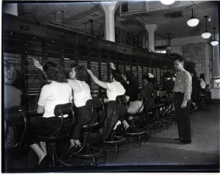Article
In the early days of the telephone, calls had to be connected manually by inserting two phone plugs into specific ports, one from the caller and one for the called, in a panel called the switchboard. The switchboard operator was the individual who connected these calls. Until the advent of direct dialing, all calls went through operators. The first telephone operator was named George William Croy, who found his "calling" in 1878. It later it became a trend in the United States for this position to be held by women, with the reasoning behind this being that women were expected to be more courteous to customers than men. Moreover, women would work for much lower wages than men, making the exploitation of their gender an integral part of the developing telecommunications industry. Because switchboard operators were often the public face of an organization, the convention of hiring beautiful women became part of the culture associated with switchboard operators, who became in some senses associated with the pretty, independent, and wholesome “All American Girl.”
"Female operators working the switchboard under male supervision, circa 1965" by Don Pinder is licensed under CC BY.
Manuscripts
References
Encyclopædia Britannica Online
N.d. Telephone.
http://www.britannica.com/EBchecked/topic/585993/telephone/279906/The-s…,
accessed April 06, 2015.
Rakow, Lana F.
1992 Women and the Telephone: The Gendering of a Communications Technology.
Urbana: University of Illinois Press.

